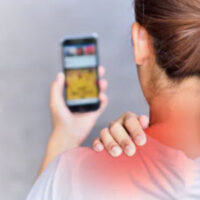A “Pandemic” Of Catastrophic Injuries Resulting for Millions Who Work from Home Due to Setups

For many, having to suddenly switch to working from home due to COVID-19 has caused a number of serious injuries. Many of those who began working from home in March believed that they would only be doing so for a few weeks and therefore neither they nor their employers arranged for an appropriate ergonomic work setup for them. As a result, according to chiropractors, there has been a surge in problems for millions of workers, who have been hunched over their laptops at home, working from kitchen counters, chairs, beds, couches, and other awkward locations for months that in no way resemble an ergonomic office setup. This has led to significant back and neck pain, as well as other musculoskeletal issues that are characteristic of overuse injuries stemming from repetitive trauma, as we discuss below:
Using Laptops
According to the experts, laptops are the main culprits in these circumstances, as they force you to look down or bring your hands up to type, which then forces your head to fall into a forward position, placing significant pressure on the spinal discs and joints, and causing muscle imbalance in the neck.
Working From Sofas, Kitchen Chairs, And Stools
The types of chairs used are also a problem: People working from home during the pandemic have been using kitchen chairs, stools, the living room sofa, etc. to do their work; all of which are not the correct height, and this prevents them from sitting in the correct posture (which, according to the experts, is: ears over shoulders over hips, which should also be higher than the knees, with arms relaxed at your sides, neck relaxed and straight, forearms parallel to ground, and feet resting on floor).
Lack of Movement
Many of us also no longer get up and move around during the day – the way we might have at work to, for example, go to a meeting, or grab coffee across the street, etc. – because these are no longer practical or automatically safe activities. Instead, most of us sit all day, which, according to chiropractors, is the worst thing for injury prevention because if you are in the same position for too long, your body will wear down, regardless of ergonomics.
Looking Down At Electronics
We are also spending more time on electronics; specifically, looking down at our phones with our necks bent (a phenomenon known as “text neck”) instead of holding them at eye level. Young children, teenagers, and college students are especially at risk because not only are they on their phones more frequently, but everything in their lives that was related to movement – such as sports and gym classes – are gone. Most are doing their work by sitting rounded over in bed, reading over their laptop or phone, and this places them at risk for developing headaches, neck tension, and shoulder pain.
If You Are Experiencing Painful Injuries After Working from Home, Speak with an Experienced Florida Personal Injury Attorney
When employees work from home and become injured, a number of legal nuances can arise. However, as long as an employee’s injury arises in the course and scope of their employment, the home environment becoming the work environment due to COVID-19 should be irrelevant. The question is whether the employment exposes the employee to conditions that contribute to the risk of injury.
If you have any questions about injuries incurred on the job, contact our experienced Tampa personal injury attorneys at the office of Mark H. Wright, PLLC today to find out how we can discuss your options with you.
Resource:
nytimes.com/2020/09/04/well/live/ergonomics-work-from-home-injuries.html
